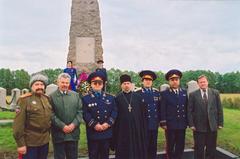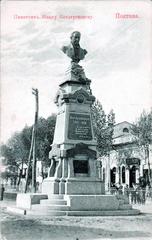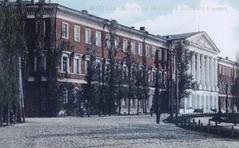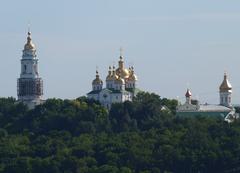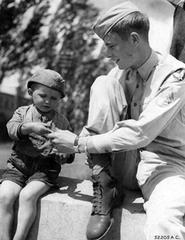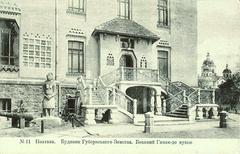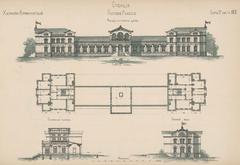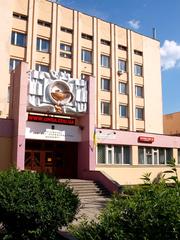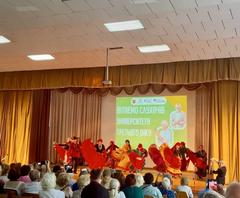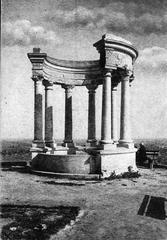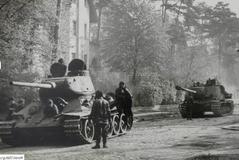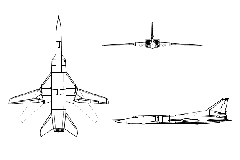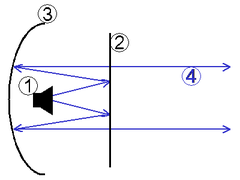Poltava Battlefield: Visiting Hours, Tickets, and Historical Significance
Date: 04/07/2025
Introduction
The Poltava Battlefield, near the city of Poltava, Ukraine, is a site of immense historical and cultural importance. It preserves the memory of the pivotal Battle of Poltava, fought on June 27, 1709, which marked a turning point in the Great Northern War and altered the course of European history. Today, the battlefield, its museum complex, monuments, and natural landscapes offer visitors a rich and immersive experience, blending education, remembrance, and local heritage. This guide provides all essential information for planning your visit, including opening hours, ticketing, accessibility, travel tips, cultural significance, and nearby attractions (discover-ukraine.info; battle.poltava.ua; visitpoltava.com).
Table of Contents
- Origins and Context of the Battle of Poltava
- Prelude to the Battle
- The Battle and Its Aftermath
- Visiting the Poltava Battlefield
- Notable Features, Monuments, and Exhibits
- Preservation, Commemoration, and Cultural Events
- Integration with Local Heritage
- Educational and Community Engagement
- Local Customs, Cuisine, and Hospitality
- Sustainable Tourism and Natural Landscapes
- Frequently Asked Questions (FAQ)
- Conclusion and Summary
- References
Origins and Context of the Battle of Poltava
The Battle of Poltava, fought on June 27, 1709 (Julian calendar), was a decisive confrontation in the Great Northern War (1700–1721). The conflict pitted the Swedish Empire under King Charles XII against Tsar Peter I’s Russia and its allies. Sweden’s defeat at Poltava marked the end of its dominance in the Baltic, while Russia emerged as a major European power. The battle profoundly influenced the fate of Ukraine and reshaped Eastern European geopolitics (discover-ukraine.info).
By the late 17th century, Sweden controlled vast territories around the Baltic Sea. Tsar Peter the Great, intent on modernizing Russia, sought to gain access to the Baltic and challenge Swedish supremacy. The Great Northern War unfolded as a struggle for regional dominance, with alliances and strategies shifting over more than two decades.
Prelude to the Battle
Charles XII’s early campaigns were marked by swift victories, but the tide turned by 1708. An exceptionally harsh winter devastated the Swedish army as it advanced into Ukraine in search of Cossack allies under Hetman Ivan Mazepa. The anticipated reinforcements did not materialize, leaving the Swedes weakened. In April 1709, Charles XII began a siege of the fortress at Poltava, but his forces—now diminished—faced a well-prepared Russian army under Peter the Great (battle.poltava.ua).
The Battle and Its Aftermath
On June 27, 1709, Swedish troops launched a dawn assault on Russian defensive lines. Despite initial gains, the Swedes were ultimately repelled by superior Russian numbers and artillery. The Russian counteroffensive broke Swedish lines, resulting in a catastrophic defeat for Charles XII’s army. Over 6,900 Swedish soldiers were killed, and 2,800 taken prisoner, while Russian losses numbered over 4,500 killed and wounded (battle.poltava.ua).
King Charles XII, wounded, escaped with a small group to Ottoman territory. The Swedish defeat at Poltava signaled the decline of its empire and the rise of Imperial Russia. For Ukraine, the battle marked increased Russian influence and a shift in the region’s historical trajectory (discover-ukraine.info).
Visiting the Poltava Battlefield
Visiting Hours and Tickets
- Museum and Visitor Center: Open daily from 9:00 AM to 6:00 PM (last entry 5:30 PM). Seasonal variations may apply; check the official website before visiting (official Poltava Battle Museum website).
- Ticket Prices: General admission for adults is about 50–100 UAH, with discounts for students, seniors, and children. Tickets can be purchased at the entrance or online. Guided tours and special events may incur additional fees (visitpoltava.com; Trip.com).
Accessibility
- The museum and main paths are wheelchair accessible, featuring ramps and accessible restrooms.
- Some historic features, such as redoubts and burial mounds, may be challenging for those with limited mobility, but paved trails and benches are available (Tourist Places Guide).
How to Get There
- The battlefield is located about 5–10 kilometers northeast of Poltava’s city center.
- By taxi: A ride from the center costs around 60 UAH; ride-hailing apps like Uklon are widely used (What Kate and Kris Did).
- By public transport: Local buses and marshrutkas (minibuses) connect the city to the battlefield.
- Organized tours: Many tour operators offer packages including hotel pick-up, guided visits, and comprehensive itineraries (Green Tour UA).
- Parking: On-site parking is available for private vehicles and buses.
Facilities and Amenities
- Restrooms, a café, and a gift shop selling books, crafts, and souvenirs are located at the museum complex.
- Guided tours are offered in multiple languages and can be booked in advance.
- Audio guides and printed information in English, Ukrainian, and Russian are available at the museum.
Practical Travel Tips
- Best time to visit: Late spring through early autumn (May–June or September–October) offers pleasant weather and special events.
- Clothing: Wear comfortable shoes and dress for the weather, as much of the site is outdoors.
- Photography: The battlefield and monuments are particularly striking at sunrise and sunset. Respect restrictions during ceremonies (Audiala).
Notable Features, Monuments, and Exhibits
- Monument to the Poltava Battle: Central commemorative structure honoring the 1709 battle.
- Reconciliation Pavilion: Built in 1909, with inscriptions in Ukrainian, Russian, and Swedish, symbolizing remembrance and reconciliation (Poltava Travellerspoint).
- Mass Graves and Burial Sites: Memorials for Russian and Swedish soldiers (Supertravelr).
- Museum of the History of the Poltava Battle: Nine exposition halls with over 8,000 artifacts, including weapons, uniforms, documents, paintings, and dioramas (visitpoltava.com).
- St. Sampson’s Church: A reflective space adjacent to the museum, commemorating the Russian victory (What Kate and Kris Did).
Preservation, Commemoration, and Cultural Events
Preservation
The battlefield has been carefully preserved as a State Historical and Cultural Reserve since 1981, encompassing over 700 hectares of largely unaltered 18th-century landscape, defensive structures, and monuments (discover-ukraine.info).
Commemoration
- Annual Events: Each July, commemorative ceremonies, lectures, and military reenactments mark the battle’s anniversary, attracting visitors from Ukraine and abroad.
- Official Ceremonies: Wreath-laying and public lectures, especially on June 27th, reinforce the site’s significance in Ukrainian memory (educba.com).
Cultural Significance
The battle’s legacy is interpreted from Ukrainian, Russian, and Swedish perspectives. Museum displays and educational programs highlight these narratives, exploring the complexities of national identity and resilience (educba.com).
Integration with Local Heritage
The battlefield is part of a broader network of historical and cultural sites in Poltava, including:
- Holy Cross Exaltation Monastery: A 17th-century Baroque landmark.
- Poltava Regional Museum: Offers further insight into Ukrainian history (earth-site.co.uk).
- Round Square: The city’s architectural centerpiece, ideal for dining and people-watching.
Educational and Community Engagement
- School Visits: The site is integral to local education, with schools organizing regular trips and special programs.
- Workshops and Lectures: The museum hosts temporary exhibitions and public lectures to foster historical understanding.
- Volunteer Initiatives: Community groups assist in site maintenance, restoration, and guiding (earth-site.co.uk).
Local Customs, Cuisine, and Hospitality
- Cuisine: Poltava is renowned for dishes like varenyky (dumplings) and borscht, available at local restaurants and cafés (earth-site.co.uk).
- Hospitality: Visitors often remark on the warmth and friendliness of Poltava residents, who are eager to share stories and recommendations.
Sustainable Tourism and Natural Landscapes
- Nature: The battlefield lies in the scenic Vorskla River valley, with meadows, ponds, and an arboretum featuring 170+ species of trees and shrubs.
- Sustainability: Preservation efforts and responsible tourism are promoted by local authorities and heritage groups (earth-site.co.uk).
- Leisure: The landscape is ideal for walking, picnicking, and birdwatching.
Frequently Asked Questions (FAQ)
Q: What are the visiting hours?
A: The museum is open daily from 9:00 AM to 6:00 PM (last entry 5:30 PM). The battlefield is accessible year-round.
Q: How much are tickets?
A: General admission is 50–100 UAH. Discounts for students, seniors, and children apply.
Q: Is the site accessible for visitors with disabilities?
A: Yes, main paths and museum areas are wheelchair accessible.
Q: Are guided tours available?
A: Yes, guided tours in multiple languages can be booked in advance or on-site.
Q: What is the best time to visit?
A: Late spring and early autumn offer pleasant weather and special events.
Q: What other attractions are nearby?
A: Holy Cross Exaltation Monastery, Poltava Regional Museum, Round Square, and Kharkivskyi Forest Park.
Conclusion and Summary
A visit to the Poltava Battlefield offers an engaging journey through European and Ukrainian history. The site’s state of preservation, extensive museum exhibits, and rich cultural events provide a multidimensional experience—honoring the memory of those who fought, educating future generations, and celebrating local heritage. Plan your trip during late spring or early autumn to enjoy the best weather, commemorative events, and full amenities. Enhance your visit by exploring nearby attractions, savoring local cuisine, and participating in guided tours.
Stay updated on hours, tickets, and events by checking official resources or using digital tools like the Audiala app. The Poltava Battlefield is more than a historical site—it is a living symbol of resilience, shared heritage, and community spirit (discover-ukraine.info; visitpoltava.com; educba.com).
References
- Visiting the Battle of Poltava Historical Site: Hours, Tickets, and What to See (discover-ukraine.info)
- Battle of Poltava History (battle.poltava.ua)
- Poltava Battle Museum and Battlefield Visitor Information (visitpoltava.com)
- Discover the Poltava Battle Field: A Journey Through History and Heritage (Wikipedia: Battle of Poltava)
- Poltava Battlefield Visiting Hours, Tickets, and Guide to Poltava Historical Sites (What Kate and Kris Did)
- Visiting the Poltava Battlefield: History, Tickets, and Local Insights (educba.com)
- Supertravelr
- Tourist Places Guide
- Poltava Travellerspoint
- Green Tour UA
- Audiala
- earth-site.co.uk
- Trip.com
- WildTrips: Poltava Attractions
